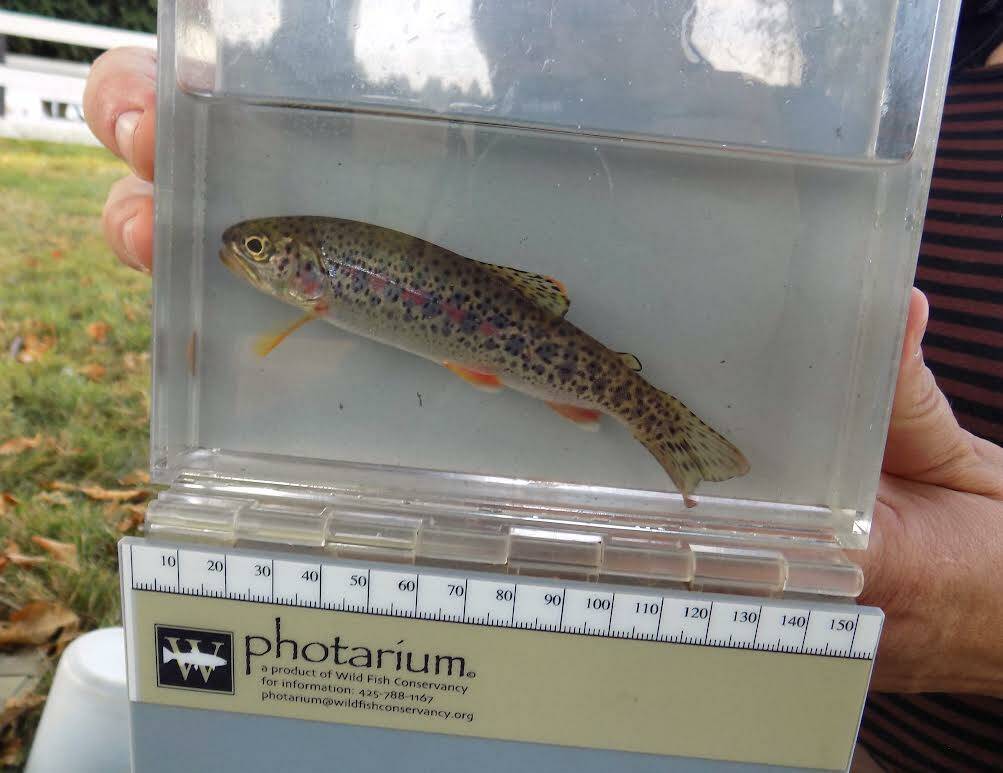By Russel Barsh, Director of Kwaiht
A flash of gold in the water…
Island streams are steep and short, fed by small headwaters lakes and seasonal wetlands. The Skagit River, which produces many of the salmon that migrate through the San Juan Islands each summer, drains an area of about 1.7 million acres. The largest streams in the islands drain fewer than 10,000 acres, and lacking a snowpack, or batteries of beaver dams, they tend to drain quickly in early summer. Twenty years ago, most island streams slowed to a dribble by September, awaiting the rains. Today, many island streams run dry by midsummer and do not flow steadily until the end of the year. How could our islands’ streams possibly sustain salmon or trout? But some still do.
Meet the toughest, scrappiest fish in the Pacific salmon (Oncorhynchus = crooked-nose) family, the Coastal Cutthroat Trout: Oncorhynchus clarkii clarkii, named for William Clark of Lewis and Clark. These relatively small, gold-hued trout thrive in some of the most extreme, inhospitable conditions on the west side of the Cascade Mountains. They tolerate summer isolation in small stream pools and higher water temperatures than other salmon can survive. Most importantly, they are masters of camouflage and deception, a necessity for surviving in shallow stream pools and glides that are hunted by bears, raccoons, otters, minks, kingfishers, herons and ravens!
If it detects the slightest movement, a Coastal Cutthroat is gone in a flash, diving beneath a rock or half-submerged log, or straight into the sand and mud. Only a patient fly-fisher can lure them out to strike a well-tied caddisfly, stonefly or midge.
Coastal cutthroats spend most of their lives in freshwater like other Cutthroat subspecies, but they make sporadic trips to saltwater to forage, and each fish can spawn multiple times.
There once were a half-dozen native Coastal Cutthroat populations in the San Juan Islands that attracted local anglers. They began disappearing 15 years due to ignorance and neglect: stream diversions, dams to fill residential ponds, undersized county road culverts, planting competitive non-native fish, and even well-intentioned but poorly designed “habitat restoration” funded by our state and county.
Two native Coastal Cutthroat populations remain, and both are now threatened by the effect of climate change on precipitation patterns, summer droughts, and stream flows. One native Coastal Cutthroat population inhabits Doe Bay Creek in east Orcas, trapped above a waterfall that has isolated them genetically since sea levels were much higher several thousand years ago. A county road remains a major concern for the survival of these fish. An even larger native trout population spawns in the stream that rises from wetlands on top of Mitchell Hill (in the National Park), and flows through farmland and pastures to Garrison Bay.
The Garrison trout are a mix of sea-run and residents, producing bright gold adults up to six or seven inches that congregate in early fall. In April, fry begin to appear in the stream where they remain, hiding in pools and sandy shallows through their first summer. Genetically distinct from all other documented western Washington cutthroat, they may number only a few hundred at this stage, their numbers are constrained by stream barrier, low summer flows, and non-native fish planted in a farm pond years ago.
The spawning reach for the Garrison trout population is located at Saturn’s Return, where owners Emma Rastatter and Wiley Webb are working with Kwiaht and the San Juan Islands Conservation District to enhance the stream corridor and manage stream flows. Like-minded neighbors, including the National Park, also bode well for the future of these fish.
Because they are scattered amongst hundreds of tiny streams from the San Juan Islands and Puget Lowlands to the shoulders of the Cascade and Olympic Mountains, Coastal cutthroat represent an unparalleled reservoir of salmonid genetic diversity. As such, they may hold the key to the adaptation of Pacific salmon and trout to a warming Salish Sea. That is, if we do not fill their streams first with roads, ponds, and homes!



